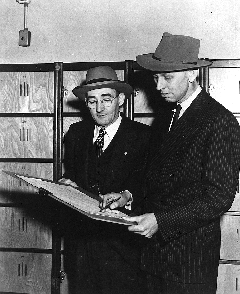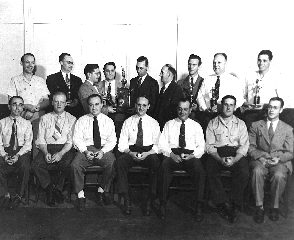GM of Indiana - Bowling Association History
This month the Bowling History column reviews the history of the General Motors of Indiana Bowling Association (GMIBA). For many years, this association ran annual tournaments for employees of General Motors (GM) within the State of Indiana.

No, these men aren't gangsters planning their next heist! It is GMIBA founder George McCartney and inaugural tournament director Fred West.
In the early 1940's, and then following World War II, bowling was growing in popularity at an enormous rate. Many bowlers traveled to tournaments on the weekends to test their bowling skills and compete against other bowlers. There was a sense of pride to represent your local area and bring home a championship.
During this same time period, there were many attempts to organize a bowling tournament for all GM employees within the state. Several matches and multi-divisional tournaments were conducted. However, attempts at forming a single association usually died in committee due to the lack of an organization strong enough to warrant company sponsorship.
As with all worthwhile endeavors, it takes a little time for the right leader to step forward to turn a vision into reality. In this case, that leader was Mr. George McCartney from Chevrolet Body Division in Indianapolis. On September 14, 1947, McCartney organized a meeting among those he knew would be interested in pulling together a GM Tournament. At that meeting, it was decided that the first tournament would be held in Indianapolis in early spring 1948. It was further decided that the tournament would be open to all GM employees in the State of Indiana. In the late 1940's, there were many GM divisions within 50 miles of Indianapolis. This created a large pool of potential bowlers to help ensure the success of the tournament.
Mr. Fred West, from the Allison Division, became Secretary for that first tournament. He had experience running leagues as well as the Moose Tournament and indicated that he could obtain the support of the Delaware Recreation Alleys to host the event. Other GM divisions represented at that first meeting included Delco Remy (Anderson), Delco Battery (Muncie), Guide Lamp (Anderson) and Chevrolet (Muncie).
The inaugural tournament was scheduled to commence on April 3, 1948. Entry fees were set at $3 per event and $1 for all-events. The entries piled in! No one could have imagined that 175 teams, 289 doubles, 512 singles and 353 all-events entries would be received for that first tournament.
The winners of that inaugural tournament were mostly from Allison Division. All the winners are shown below.
Team Actual - Allison
Wayne Ross
Frank Kagle
Carl Hogue
Toivo Lahti
Russell Bellinger
Team Handicap - Allison
Todd Wilbur
Lowell Green
Chuck Ingoldsby
Frank Sourbier
Jim Jung
Doubles Actual - Chevrolet Indianapolis
Harold DeHoff
William Power
Doubles Handicap - Allison
Paul Noe
Leland Thurston
Singles Actual - Allison
Paul Thistlethwaite
Singles Handicap - Allison
Charles Binsbacher
All Events Actual - Guide Lamp
G. Bauner
Most of these champions are shown in the photograph below.

Following the huge success of that first tournament, a meeting was organized to pull together all of the personnel representatives from the various GM divisions in Indiana. Upon seeing the success and some organizational structure behind the tournament, they decided to contribute $5 per team to the prize fund for future events.
The second tournament was conducted at the Welper-Abel Recreation Alleys in Anderson in 1949. The entries jumped up to 246 teams, 440 doubles, 801 singles and 742 all-events. It was obvious that this tournament was going to be a force for many years to come.
Next the group drafted a constitution and obtained final approval on July 19, 1949. The organization would operate from this basic constitution for almost 50 years! The constitution called for a president, vice-president and secretary. The vice-president succeeded the president to provide continuity. The secretary was responsible for running the tournament and, therefore, was from the GM division hosting the next tournament.
The constitution also called for two meetings, one in the spring and one in the fall. The spring meeting was used to finalize the tournament plans and elect officers. Tournament bidding and arrangements were decided at the fall meeting. The constitution also called for two representatives from each GM division to provide communications back to their respective organizations.
Several changes were made throughout the years.
Beginning with the 1955 tournament, bowlers had to participate in both doubles and singles. Prior to that time, they could participate in singles only.
Upon the 50th anniversary of Delco Battery in 1958, the custom of having the host division provide a souvenir was started. Over the years, coffee cups, pocket knives and other small items were provided by the host division.
In 1959, a tournament series was conducted on the same pair of lanes for the first time. Prior to that, each game was bowled on a different pair of lanes. That same year, the president's term was extended to two years.
The tournament changed from a bid system to a rotation system in 1964. This approach allowed each division to host the event on an equal basis. It also allowed the divisions to better plan their events since they knew what year they would be hosting the tournament.
Much of this early history of the GMIBA was obtained from a 15 year history compiled by past-presidents of the organization in 1962.
The tournament continued to grow over the years. Team entries peaked at 400 teams in 1963. That same year there were 1672 singles entries. To give you a feel for the size and success of the GM Tournament, that same year there were only 738 teams in the Indiana State Tournament.
Tournament participation declined to about 225 teams by the early 1970's. Further declines resulted as some of the divisions were downsized or sold by GM. This also affected league bowling in the towns involved. The local divisions ceased their $5 contribution to the prize fund for each team they entered. For these and other reasons, tournament participation dropped to about 50 teams in its last few years.
Eventually, the entries decreased to the point that the association questioned whether the tournament should be continued. The association tried their best to keep the organization alive. They tried various new ideas, incentives and involving the new assembly plant in Fort Wayne. However, their efforts were not successful.
As it turned out, the final tournament (47th annual) was held in December, 1993. The association planned to run a tournament in December, 1994 but only 11 entries were received by the deadline. A total of 21 entries were eventually received but, due to poor communications between division representatives the tournament had already been cancelled due to lack of participation.
A committed group of veteran GMIBA representatives including Joe Pendick (Truck - Indianapolis), Harry Kirchenbauer (Inland Fisher Guide - Anderson), Carroll Faucett (Delco Remy - Anderson), Herald Auker (Inland Fisher Guide - Anderson) and Jon Kelley (Delco Electronics - Kokomo) reluctantly agreed to disband the GMIBA on February 5, 1995. I can tell you that is was a sad time, knowing all the effort put in over the years, forming the association and building the tournament base.
Additional GM divisions, or their earlier names, participating in the tournament over the years not already mentioned above include: Fabricast or Central Foundry in Bedford, Detroit Diesel Allison Division, Allison Transmission, Allison Gas Turbine, Delco Radio, Fisher Body or CPC from Marion, GMAC in Muncie and United Motors Services and GMAC in Indianapolis.
See the attached table for all the Kokomo champions from the GM of Indiana Bowling Association.
Bowling today has largely lost the camaraderie of bowling with fellow workers. I believe this is a significant factor in the reduction of league bowlers in many towns. Locally, we still have the Delco and Chrysler leagues, but there are fewer of them and they are smaller in size. In some cases, these leagues are no longer restricted to employees in order to keep the leagues running at capacity.
Kokomo's GM Tournament Champions
|
TEAM |
DOUBLES |
SINGLES |
ALL EVENTS |
|
Delco Mavericks - 1960 (A) |
Tom Dinwiddie and Mike Wikel - 1963 (A) |
W. Francis - 1957 (H) |
W. Francis - 1957 (H) |
|
Uncouth 5 - 1962 (A) |
Byron Snow and Bryan Thurmond - 1968 (H) |
Dan Gibson - 1971 |
B. Glenn - 1961 (H) |
|
Uncouth 5 - 1964 (A) |
Dick Stanley and Harry Westcott - 1972 (A) |
C. Forker - 1973 (H) |
Jim Kenworthy - 1964 (H) |
|
Kokomo Kowboys - 1969 (A) |
Joe Sallee and Tom Dinwiddie - 1976 (A) |
Tom Dinwiddie - 1975 (A) |
Dick Stanley - 1967 (A) |
|
Live Wires - 1969 (H) |
Ed Hinkle and G. Hanaway - 1976 (H) |
Tim Lindgren - 1979 (H) |
Terry Aeschilman - 1970 (H) |
|
Firehouse Five - 1971 (A) |
John Ring and Don Shenk - 1986 (H) |
Larry Moss - 1982 (H) |
Jim Kenworth - 1972 (A) |
|
Firehouse Five - 1972 (A) |
Dick Harrison and Bill Stewart - 1988 (H) |
Jon Kelley - 1987 (A) |
Gary Luttrell - 1974 (H) |
|
Regulators - 1976 (H) |
Ralph Taylor and Matt Sale - 1989 (H) |
Floyd Russell - 1988 (A) |
Dick Johnson - 1982 (A) |
|
Plant 9 Dept 951 - 1982 (A) |
Matt Sale and Ralph Taylor - 1990 (H) |
Matt Sale - 1991 (H) |
Larry Moss - 1982 (H) |
|
Strikers - 1982 (H) |
Bob Lindsay and Bob Meyer - 1993 (H) |
Dudley Williams - 1993 (H) |
John Ring - 1986 (H) |
|
Firehouse Five - 1986 (H) |
Jeff Wood and Gary Exmeyer - 1994 (A) |
Dave Wolfe - 1994 (A) |
Floyd Russell - 1988 (A) |
|
Ed's Pro Shop - 1988 (A) |
|
|
Floyd Russell - 1989 (A) |
|
Ed's Pro Shop - 1989 (A) |
|
|
Dave Wolfe - 1993 (A) |
|
Cedar Crest Pro Shop #2 - 1990 (A) |
|
|
Terry Beale - 1994 (A) |
|
Delco's Best - 1990 (H) |
|
|
|
|
Hitmen - 1993 (A) |
|
|
|
|
Macho Studs - 1994 (H) |
|
|
|
